

 Photo by Akin Diler, airliners.net
Bird strikes happen every day. Indeed, almost every pilot will be able to tell you a story about them. Most of the occurrences are inconsequential. In less than 10% of the cases, however, they result in damage to the aircraft and, in the worst case scenario, in fatal accidents, which have caused 229 lives to be lost since 1988.
The most critical phases of flight for bird strikes are take-off and initial climb, which means that the most problematic issue is the presence of birds at or near airports. It is therefore the task of the airport team in charge of runway safety issues (Local Runway Safety Teams) to look for solutions and mitigating measures.
Photo by Akin Diler, airliners.net
Bird strikes happen every day. Indeed, almost every pilot will be able to tell you a story about them. Most of the occurrences are inconsequential. In less than 10% of the cases, however, they result in damage to the aircraft and, in the worst case scenario, in fatal accidents, which have caused 229 lives to be lost since 1988.
The most critical phases of flight for bird strikes are take-off and initial climb, which means that the most problematic issue is the presence of birds at or near airports. It is therefore the task of the airport team in charge of runway safety issues (Local Runway Safety Teams) to look for solutions and mitigating measures.
 Photo by John Musolino, airliners.net
After carrying out a risk assessment, some first-step basic measures can be taken, such as making the airport area as unfriendly as possible to birds, e.g. avoiding water and specific vegetation. Reporting is another key element: pilots need to report all occurrences, to help improve knowledge and awareness of birds near airports.
Nevertheless, in some areas with a high presence of birds, these measures are not enough. This is the reason bird detection techniques are under development for two different applications:
Photo by John Musolino, airliners.net
After carrying out a risk assessment, some first-step basic measures can be taken, such as making the airport area as unfriendly as possible to birds, e.g. avoiding water and specific vegetation. Reporting is another key element: pilots need to report all occurrences, to help improve knowledge and awareness of birds near airports.
Nevertheless, in some areas with a high presence of birds, these measures are not enough. This is the reason bird detection techniques are under development for two different applications: